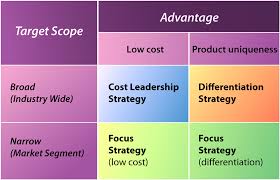In a nutshell, over my past 10 posts, I have advocated that most private colleges and universities should pursue a focused differentiation strategy based on a unique mission and vision that solves a significant problem for its target customers. My last few posts on this topic will address how schools determine which points of differentiation will offer them a significant competitive advantage over their competition that can be sustained over time.
Sustained competitive advantage comes from the internal resources and capabilities of the organization. And not just any resources and capabilities. They have to meet specific criteria (VRIN – sorry, another mnemonic device):
Valuable – Allows the school to solve a serious customer problem
Rare – Not widely held by the competition
Inimitable & Non-substitutable – Competitors can’t easily imitate it or substitute something else equally valuable for it
Valuable, rare, inimitable, and non-substitutable resources and capabilities are usually going to be intangible. Have an illustrious group of alumni? A campus on a plum piece of real estate? An award-winning, LEED-certified student union building? A faculty full of Fulbright scholars? Chances are that your competition does as well, or can offset that resource with something else (i.e your green building initiative = my big stadium and winning football program). These sorts of resources simply cannot lead to a sustained competitive advantage. They are widely held, and don’t solve the problems faced by today’s students. In fact, to the extent that they make tuition skyrocket, they’re making the problem worse.
If this is the case, then why do so many schools seek to enhance their reputations by going on building sprees, making huge investments in winning sports teams, luring star researchers, spending millions on ancillary student life enhancements, and the like? I contend that the answer is that these tangible things SEEM like they will make the school more attractive to students, and students may actually say they like them. However, the trick is to take these tangible, widely held resources, and find ways to use them that benefit the students and cannot easily be replicated by the competition. Some examples:
- Schools often brag about their large number of alumni, but do they actually know where these alums are? Are the alums actively engaged with the school? The ability to attract and engage alums in productive ways is a true distinctive capability for a school.
- Schools often brag about their excellent faculty and star researchers, but are these faculty accessible to the students? How often do these professors teach? Hold office hours? Creating a faculty culture of engagement with students is a critical and rare capability among all universities, particularly ones that aren’t Carnegie Research I institutions.
- Schools often brag about their excellent liberal arts core and highly sought after professional majors, but are these two areas integrated? Do they flow together, or are the students just offered a smorgasbord of class offering and told how many to choose from each area? Truly integrating the academic silos of the university and advising students on how to best chart their path through the curriculum is a rare and valuable capability.
- Schools often brag about their job placement rates and career services, but how strong are their relationships with local employers? Do they consult with the employers about what skills their new hires will need? Do they integrate those skills into the curriculum? Have they created a smooth transition from classroom to internship to employment? Integrating careers and academics into true experiential educational opportunities is another rare and valuable capability.
These are just a few examples. There are many others, and each school must look closely at their current situation and aspirations to determine what their distinctive capabilities should be. The point is that these intangible capabilities, rather than tangible resources, are more likely to lead to true competitive advantage that is sustained over time.
